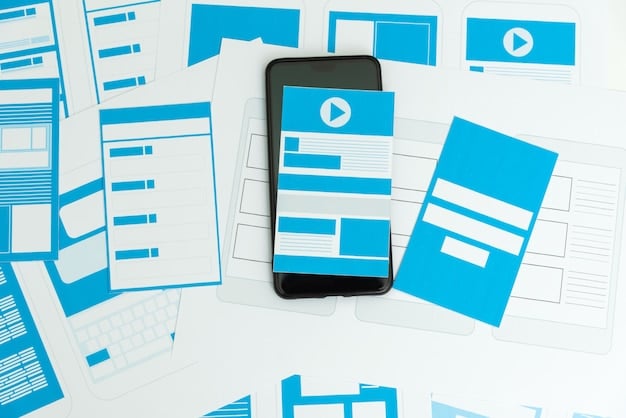Navigate Body Image Triggers on Social Media in 2025

Advertisements
Navigating body image triggers on social media in 2025 requires a proactive approach focusing on mindful consumption, personalized content curation, and robust self-care strategies for a healthier online experience.
Advertisements
Social media’s influence on body image can be significant, leading to both positive and negative impacts. As we move into 2025, understanding and managing these influences is crucial for maintaining a healthy self-perception. This guide provides effective strategies to navigate body image triggers on social media in 2025, ensuring a more positive and empowering online experience.
Understanding Body Image Triggers on Social Media
Advertisements
Body image triggers are stimuli, often found on social media, that spark negative thoughts and feelings about one’s own body. Recognizing these triggers is the first step in managing their impact. They can range from heavily edited photos to unrealistic fitness goals promoted by influencers.
Common Types of Triggers
Understanding the different forms these triggers take can help you better prepare for and cope with them.
- Edited Images: Photos and videos altered using filters and editing tools to create an unattainable standard of beauty.
- Comparison Culture: The tendency to compare one’s life and body to the curated images and lifestyles presented online.
- Weight Loss Ads: Targeted advertisements and promotions for weight loss products and programs that can fuel insecurities.
Why Are These Triggers Effective?
These triggers work because they tap into our innate desire for social acceptance and belonging. The constant exposure to these idealized images can distort our perception of reality, making us hyper-aware of our perceived flaws.

Body image triggers on social media are powerful because they often play on deep-seated insecurities and societal pressures. However, by understanding what these triggers are and why they affect us, we can start to develop healthier habits and boundaries.
Cultivating a Mindful Social Media Diet
Just as you curate your food diet, cultivating a mindful social media diet can significantly improve your body image and mental health. This involves being intentional about the content you consume and the platforms you engage with.
Unfollow or Mute Accounts
One of the most effective ways to control your social media environment is to unfollow or mute accounts that consistently trigger negative feelings. This could include influencers, brands, or even friends whose content promotes unrealistic standards.
Seek Diverse Representation
Actively seek out and follow accounts that promote body diversity and inclusivity. Diversifying your feed with different body types, ethnicities, and abilities can help normalize a broader range of beauty standards.
Consuming a diet of social media that celebrates diversity can have a profound effect on your self-perception. It helps shift your focus from comparison to appreciation, fostering a more positive and accepting mindset.
Personalizing Your Content Curation
Algorithm-driven feeds can inadvertently perpetuate harmful body image standards. Actively personalizing your content curation can help regain control over what you see and engage with.
Adjust Algorithm Settings
Most social media platforms offer settings to manage your content preferences. Take the time to explore these options and adjust them according to your values and goals.
- Limit Exposure: Reduce the frequency of certain types of content appearing in your feed.
- Explore Interests: Indicate your preferences for content that aligns with your interests and values.
- Block Ads: Utilize ad blockers to minimize exposure to targeted ads promoting unrealistic beauty standards.
Engage Intentionally
Be mindful of the content you engage with. Liking, commenting, and sharing posts signals to the algorithm what you want to see more of. Choose wisely and prioritize content that uplifts and inspires you.

Personalizing your content curation is about taking charge of your digital environment. By actively managing your feed, you can create a space that supports your mental and emotional well-being.
Implementing Self-Care Strategies
Self-care is essential for building resilience against the negative impacts of social media. Incorporating regular self-care practices into your routine can help you maintain a healthy body image and overall sense of well-being.
Practice Gratitude
Regularly acknowledging and appreciating what you love about yourself and your life can shift your focus away from perceived flaws. Keep a gratitude journal or practice daily affirmations.
Limit Screen Time
Setting boundaries around your social media use can prevent overexposure to triggers. Designate specific times for checking social media and stick to those limits.
Engaging in self-care strategies helps you cultivate a sense of self-worth and resilience that can buffer against the negative impact of social media. It’s about prioritizing your mental and emotional well-being.
Building a Supportive Online Community
The online environment can have both positive and negative impacts on body image, depending on the communities you engage with. Building a supportive online community can provide encouragement, validation, and a sense of belonging.
Connect with Like-Minded Individuals
Seek out online communities and groups that promote body positivity, self-acceptance, and inclusivity. These spaces can offer a safe haven from the pressures of mainstream social media.
Share Your Own Story
Sharing your own experiences with body image can be empowering and liberating. Connecting with others who understand what you’re going through can foster a sense of solidarity and support.
A supportive online community can provide a sense of belonging and validation that counters the negative influences of social media. It’s about finding spaces where you feel accepted and celebrated for who you are.
Staying Informed and Adaptive
The social media landscape is constantly evolving, so it’s important to stay informed about emerging trends and adapt your strategies accordingly. New platforms, filters, and challenges can all have an impact on body image.
Follow Industry Insights
Stay updated on the latest research and discussions about social media and body image. Following experts and organizations in this field can provide valuable insights and strategies.
Reflect on Your Experiences
Regularly reflect on your own experiences with social media and body image. What triggers are most impactful for you? What strategies have been most effective? Adjust your approach as needed.
Staying informed and adaptive is about taking a proactive and critical approach to social media. By understanding the evolving landscape and reflecting on your own experiences, you can navigate it with greater awareness and resilience.
| Key Point | Brief Description |
|---|---|
| 😊 Mindful Consumption | Be aware of what you consume on social media. |
| ✨ Adjusting Algorithms | Manage content preferences for a healthier feed. |
| 🌱 Self-Care | Practice gratitude and limit screen time. |
| 🤝 Supportive Community | Connect with like-minded individuals online. |
FAQ
▼
Common triggers include edited images, comparison culture, targeted weight loss ads, and unrealistic fitness goals promoted by influencers and brands creating pressure for aesthetic perfection.
▼
Unfollow accounts that make you feel insecure, seek out diverse representation, adjust algorithm settings to limit exposure to harmful content, and engage with content that uplifts and inspires you.
▼
Practice gratitude by focusing on what you appreciate about yourself and your life, limit screen time to reduce exposure to triggers, and incorporate activities that promote overall well-being, like exercise or hobbies.
▼
Look for online communities and groups that share similar values, like inclusion or body positivity, and participate in the conversations. This offers opportunities for validation and a sense of belonging, reducing the impact of harmful content.
▼
Take a break immediately, practice deep breathing or a mindfulness exercise, and remind yourself that social media often isn’t real life, and that everyone has unique qualities that don’t always appear online.
Conclusion
Navigating body image triggers on social media in 2025 requires a combination of mindful consumption, personalized content curation, self-care strategies, and a supportive online community. By taking proactive steps to manage your digital environment, you can cultivate a healthier relationship with social media and a more positive body image.





